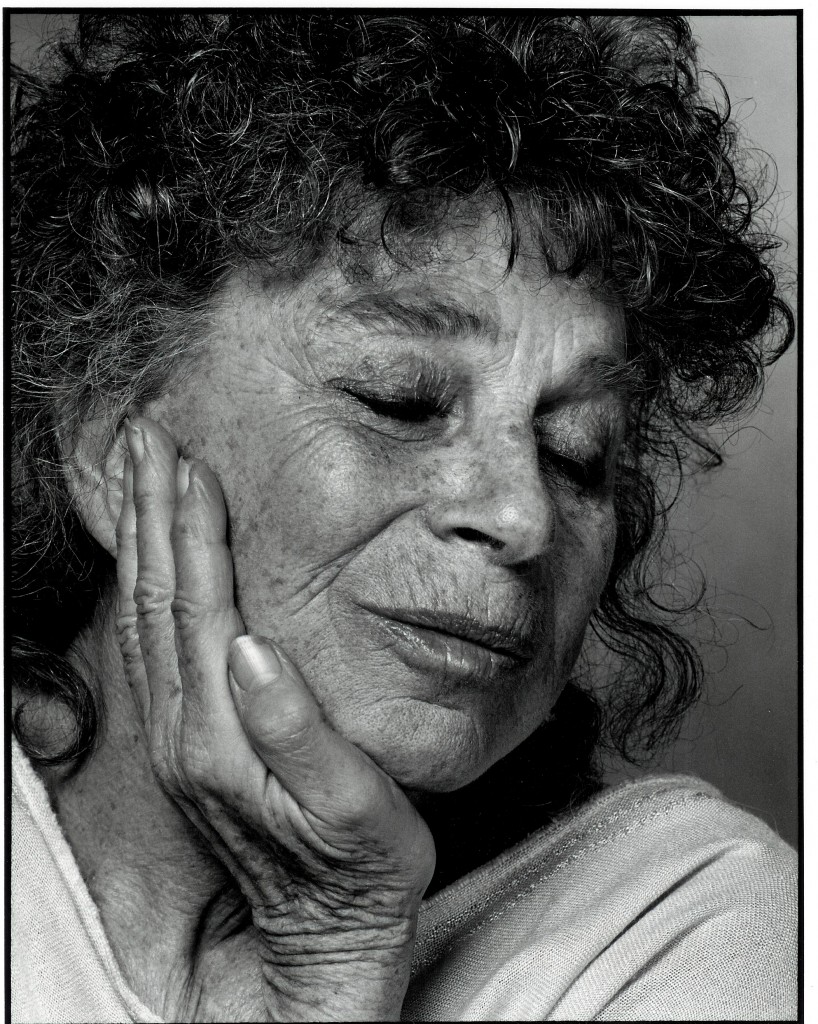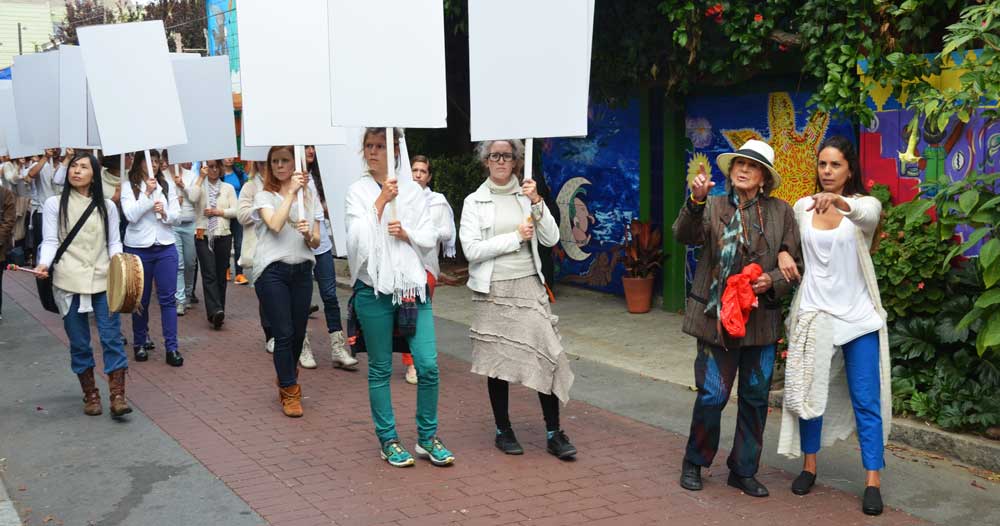Anna Halprin Turns 95
An Interview with Rosario Sammartino
BY EMMALY WIEDERHOLT
This coming July 12, 2015, Anna Halprin celebrates her 95th birthday. Few people have left such an indelible mark on both the dance world and the world at large as Anna. In order commemorate her incredible 95 years, I interviewed Rosario Sammartino, a longtime student under Anna. Rosario now serves as associate director of the Tamalpa Institute, which Anna and her daughter Daria cofounded in the 70s to serve as the educational and workshop center for the Halprin work and its evolution. To learn more about the worldwide birthday celebrations visit DancesForAnna.org. To read Anna’s interview she gave to Stance on Dance in 2013, visit here.
Anna Halprin; Photo by Kent Reno
~~
How did you come to meet and study under Anna?
I’m from Buenos Aires, Argentina. I came to California about nine years ago in search of a new way of doing psychology. I had studied psychology in Buenos Aires and got my license when I was very young; I was only 23 years old. With my license in hand, I began working in a psychiatric hospital with patients with schizophrenia. At 23 and with a traditional background in psychology, I often didn’t know what to do with my group of patients, so I started using the arts — I brought music, costumes, crayons and paper and started to make art with the patients. I started to realize the patients were able to tap into their creative force. Through art, they were able to make contact with their life story and emotions. I was amazed. In those times in Argentina, there was no formal dialogue about psychology and art coming together.
I heard about a new movement: expressive arts therapy, which uses arts for healing and change. I went to an expressive arts conference in North Carolina and met Daria Halprin, Anna’s daughter with whom she cofounded the Tamalpa Institute. Daria was teaching a workshop, and I fell in love with the Tamalpa work. It was what I was dreaming of and looking for. I trained at the institute and never left, and here I am today; I’m now core faculty in the training program and the associate director of the institute. That’s how I came into Anna’s world, searching for new eyes to see and new ways of engaging human beings in their full dimension.
How does the Tamalpa Institute carry out Anna’s legacy and your own work?
The institute was founded in 1978 by Anna and Daria to serve as the educational and workshop center for the Halprin work and its evolution, with the aim of building a bridge between dance/movement, the expressive arts, psychology, performance and the developing field of somatics. During the 50s and 60s, dancers, poets and musicians were all drawn to collaborate with Anna in search of the intersection of life and art. Anna was always interested in breaking barriers around modern notions of dance. She looked into questions like: who can be a dancer? What is dance? Why do we dance? She questioned the idea that technique and style define a dance or dancer. She brought back the human experience into the heart of dance and became interested in how as people experience and explore their art, they are also deepening into their life. For example, when someone is expanding their movement repertoire, they’re also expanding their imagination and their connection with their emotional body.
From this grew the Tamalpa Institute. The Institute is a movement-based expressive arts school that teaches the uses of movement and dance for healing, social change and education. Daria studied all her life with Anna, and became very invested in studying the connection between therapy and art. She brought these influences to the forming of the Tamalpa Institute where she worked on developing the bridge between movement, art and psychology that informs the approach today. Together they cofounded the institute in order for people to be able to incorporate this work and bring it into their own communities.
That’s what I’m passionate about — how to keep looking for embodied ways of doing psychology, art and social change. I’m looking for ways to come back into the body, and that’s what we do at Tamalpa. It’s an incredible school; people come from all over the world and many cultural backgrounds — psychologists, performers, musicians, educators, social activists, even people from business backgrounds. It’s amazing.
One of the things that fascinates me about this work is that it is always in conversation with the world around us. It’s an organic type of work; it’s not in a status quo system. It’s always in dialogue, and that defines and shapes it.
Is there an aspect of Anna’s work that particularly resonates with you?
What I’m very interested in is taking somatics, dance and embodiment into communities in need. That’s my passion. Often what happens is somatics, dance, depth psychology, dream work — all these juicy bodies of work that can be so transformative — never reach places and communities in need. The people with access are lucky and have the luxury to spend time in their bodies and work through their emotional lives. I’m interested in reaching communities who don’t have access to this type of work. Food and shelter are basic needs, but so is creativity and the right to be in your body. It’s a necessity. When people are able to tap into their creativity, the life force that comes forward is very empowering. I’ve worked in the jail system, with homeless populations and with at-risk youth. At Tamalpa we have a program called Art Corps which is a social engagement program where we sponsor our graduates to take this work into at-risk communities in different parts of the world. I love supervising that kind of work.
When you see what this work can do and the change it can create in the face of challenges, it’s really transformative and empowering.
To me, that’s where Anna’s legacy is, in using dance and the arts to create change and transform. That’s what her work has always been about. Back when there was racial tension in the 60s, she created a multi-racial dance company. It was the first one in the country. She worked with a black community and at the same time she was working with a white group, and then she brought them together. She was breaking boundaries and barriers by asking what are our similarities and differences and how we can dance together.
When the AIDS challenge became visible in the 90s and nobody wanted to talk about it, she started a group with people fighting AIDS called Positive Motion. Later, she worked with elders. As she got older and faced questions about aging, she danced those questions. She’s always been very engaged in dialoging what’s happening in life, not just isolating dance as if it was something outside of life. She asks: how can I keep exploring and engaging through dance? How can dance deepen our understanding of the phenomena happening in the world?
How do you foresee Tamalpa moving and growing in the future?
Five years ago we started opening branches abroad. We’ve opened branches in Korea, France, Germany, the UK and Latin America. People are able to train in the work in different countries around the world, and then they come to California to complete their studies. What I see happening in the future is more and more people all over the world teaching and practicing this kind of work. I see many other programs happening in communities in need. Right now we have one in Calcutta for human traffic survivors and in Argentina for people living in city slums. I imagine all of this will grow, expand and become stronger. This is all just starting for us. In the future we will become more established and the work will simply continue to grow. It will continue changing colors with the influence of people all over the world taking part.
Rosario and Anna in What Matters to Us?: A Reenactment of Anna Halprin’s Blank Placard Dance, Saturday, May 16, 2015, San Francisco


